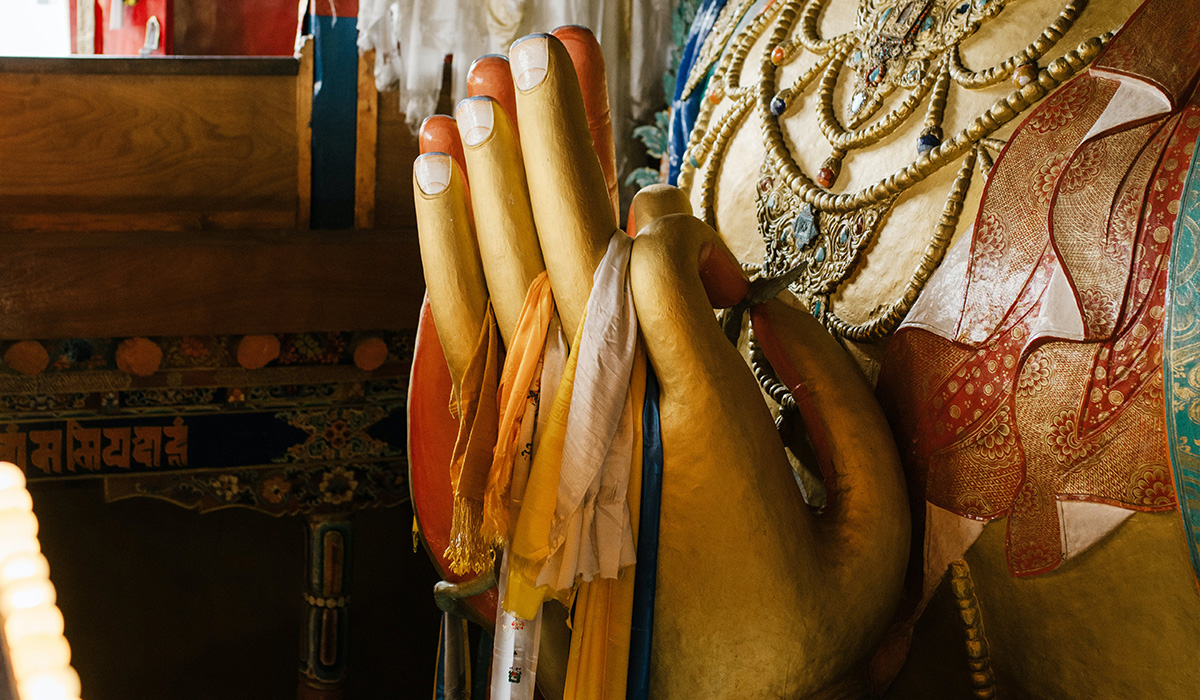Question: “I’m a longtime practitioner but one thing that vexes me is chanting: it feels, to me, artificial, forced—and too often I can’t say I understand what it is that I’m chanting. Any advice for how to recalibrate my approach to chanting?”
Chris Jay: Well, I can certainly understand the experience that leads to your question. Once, Orgyen Topgyal Rinpoche commented to Dzongsar Khyentse Rinpoche that if Westerners continue chanting in Tibetan, the dharma will be dead in fifty years. If you want to chant in Tibetan, he said, then learn Tibetan well enough so you can read and converse in the language.
There is something mind-numbing, isn’t there, about hours of chanting in a language that we don’t know. How many of us, myself included, have developed the ability to chant along while thinking about something else entirely?
The purpose of chanting in a group is to fully engage our three doors—body, speech, and mind—and orient them towards enlightened expression. Certainly monasteries and nunneries, with their chanting, music, and dance perfectly choreographed, perfected for centuries with the sole intent to bring about realization and experience, cannot be dismissed as no longer relevant. We have to ask ourselves, how could we replicate this if we were chanting in our native languages?
Let’s set our intention and aspiration right now: this is about liberating sentient beings, bringing them to full and complete enlightenment, and orienting our body, speech, and mind toward accomplishing that. This is about ensuring that our pujas and practices have Guru Rinpoche’s two crucial points: View as vast as the sky, with Action as subtle as a grain of flour. Our purpose is not to replicate a cultural experience.
So, how do we chant in our native languages in a way that inspires? At an all-English language drupchen [meditation retreat led by a high lama] in 2016, DJK Rinpoche asked Harry Einhorn and myself to develop new melodies for singing sections of the sadhana. After several days of work, we went to Rinpoche’s room to sing for him what we had developed. After listening, he gazed wistfully and said, “The Tibetans must have had to do this a thousand years ago.” Imagine the scene: yogis, monks, musicians, and chant masters sitting around trying melodies and chanting formulas, repurposing the Central and South Asian war instruments for use in the monasteries. Can we even imagine how different it must have sounded from pujas chanted in Sanskrit? And what did the pujas sound like in Indonesia, Khotan, or the Gandharan empire?
So now, I feel that it is not certain that Vajrayana has been planted in the West in a way that will last for generation after generation. As DJK Rinpoche tells us, we must develop ways of chanting and choreographing pujas and rituals that future generations will find inspiring and will want to learn. The Tibetans cannot help us with this; we must do it ourselves, he said. Just listen to our young people all over the world offering the Triratna Anusmrti Sādhāna, with their enchanting melodies and mudras. This is a good start indeed. Now, are we up to the challenge to design and choreograph all our pujas so that they inspire and magnetize practitioners?
Zenju Earthlyn Manuel: When I hear your question I hear, what is the role of chanting within meditation? Many of the chants used in Buddhist centers are so ancient that even the language is incomprehensible—not only to those who don’t speak the language, but to those who do.
The first time I chanted the Heart Sutra, I felt a sense of liberation, and I didn’t understand the words at all—and they were in English. I didn’t understand how all the negative thoughts I had walked into the meditation hall with were suddenly not present while chanting. After the service, I ran to request a copy of the chant. The reply was “no.” I am so glad that they did not give me what I wanted. I am glad the teacher saw my attempt to make an intellectual journey out of the words—to dissect them—when I had already experienced the medicine of the chant in my body.
Chanting is a powerful way to experience oneness. To merge our many voices as one sound is to join together in an intimate way, like we do with our breath when sitting together. There is one mind, one heart.
At dawn in many Zen Centers, the dark no longer able to hold back the light, the chanting begins. Few are excited. Some are barely awake, after having already sat several periods of zazen. Because we have walked from the zendo to the Buddha Hall, it may seem that we have left the ritual of meditation. Chanting is part of the ritual of stillness.
Offerings are made, and we begin using our voices in a place where silence usually reigns.
However, we will be using our voices in a different way. We will not be speaking our words. We will not be speaking of our suffering or joy. Mostly, we will utter sounds that are meant for the “gods”—which is to say, sounds that can light up a dark cave if sung with our hearts. Sounds that could bring chills and tears. Sounds that awaken the radiant fire within.
It can be frustrating when experiencing something that is out of the ordinary. We are so quick to make it fit our personal likes and dislikes. We forget that the practice does come from distant lands and cultures. It is difficult to take in the whole practice, so we find ourselves picking and choosing.
Try chanting without trying to grasp it or to make it beneficial to you, and you only. See the chanting as a collective activity, an extension of meditation or zazen, a time to join in the interconnection of sound and breath.
Ayyā Medhānandī: Have you ever tried chanting to learn its hidden powers as a channel for disarming obsessive thought, calming the mind, and preparing the ground for Nibbana to arise?
From ancient times, sacred chants have invoked higher energies, adorned rituals, and expressed faith, homage, healing, and celebration. More potently, chanting is a leavening agent, an internal cleansing that divests the mind of toxins and impurities, freeing it from its insatiable habit of feeding on thought.
We chant not to remember words or conform to rituals but to unify our attention through repetition. Whether silently observing the breath or intoning mantras, verses, and words of reverence and praise for the highest, the mind is trained to stay present. With sound, we enter the selfless vibration of it—not the doer “doing” it. We open to being what we truly are, rather than what we think we are.
When we chant pure sounds, the body becomes an instrument. We viscerally interact with our environment through vibrations—sound energies reverberating within and flowing out again. More practice yields more pure sound until we are silent, for silence is the ground of being, and of sound.
One way animals restore themselves after an attack and regain equilibrium is through the trembling of the body. We too, as humans, can intone rhythmic vibrational waves that relieve us of locked-in fears, grief, anger, or regrets and restore us to profound inner peace. The senses unify and soak in the sound of the breath itself. Trusting the heart’s innate goodness, we feel uplifted and restored. We connect in the same chord of pure presence born from our purity of intention.
In village India, I learned from local women how to remove debris from raw rice using a flat basket “plate.” They toss the rice up and down in the basket so that any grains of sand, small stones, or other detritus separate to one side while the cleaned rice remains on its own.
Chanting does just that for our mental health, removing debris from the mind and tuning us to the pure resonance within us. As we chant to that frequency, we balance inwardly—as if we were grains of rice bounced up and down until all the detritus of life’s painful memories and past traumas are evacuated from our system.
These intonations are both fathomless and timeless. Indeed, our life is a spiritual chant, from the cry of a newborn to the last ebbing of consciousness into the arms of our karmic unfolding. And if the heart is pure, we shall hear the sound of silence at the dawn of its awakening.
So may you chant with all your heart and bless the moment.

